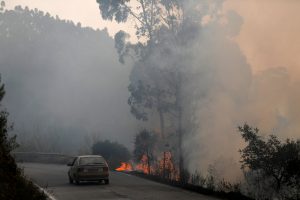By Scott DiSavino
(Reuters) – California will have its first test of plans to keep the lights on this summer following the shutdown of the key Aliso Canyon natural gas storage facility as temperatures in the Los Angeles area are forecast to hit triple digits this week.
With record-setting heat and air conditioning demand expected in Southern California, the state’s power grid operator issued a so-called “flex alert,” urging consumers to conserve energy to help prevent rotating power outages – which could occur regardless.
Electricity demand is expected to rise during the unseasonable heatwave on Monday and Tuesday, with forecast system-wide use expected to top 45,000 megawatts, said the California Independent System Operator (ISO), which manages electricity flow through the state. That compares with a peak demand of 47,358 MW last year and the all-time high of 50,270 MW set in July 2006.
That could put stress on the power grid, particularly with the shut-in of Aliso Canyon, following a massive leak at the underground storage facility in October. The facility, in the San Fernando Valley, is the second largest storage field in the western United States, according to federal data, and therefore crucial for power generation.
All customers, including homes, hospitals, oil refineries and airports are at risk of losing power at some point this summer because a majority of electric generating stations in California use gas as their primary fuel. In April, millions of electric customers in Southern California were warned they could suffer power outages on up to 14 days this summer due to the closure.
The ISO said it was working with gas and power utilities and state energy agencies to mitigate potential reliability issues related to the limited operations at Aliso Canyon.
“We are confident we have a strong plan in place to meet the operational challenges posed by the upcoming hot temperatures,” ISO CEO Steve Berberich said, adding that consumer conservation efforts would be key.
ROTATING OUTAGES
Since the energy crisis of 2000-2001, the ISO has imposed short rotating outages in 2004, 2005, 2010 and 2015, mostly related to unexpected transmission line or power plant outages during periods of unusually high demand.
Southern California Gas (SoCalGas), the nation’s biggest gas distribution utility and owner of Aliso Canyon, detected the leak in October and plugged it in February.
SoCalGas is a unit of California energy company Sempra Energy.
State regulators will not allow SoCalGas to inject fuel into the facility until the company inspects all of its 114 wells.
Aliso Canyon is the biggest of four SoCalGas storage fields. It provides service to the region’s 17 gas-fired power plants, hospitals, refineries, and other key parts of California’s economy.
In the summer (April through October), SoCalGas strives to completely fill 86.2-billion cubic feet (bcf) Aliso Canyon to prepare for the upcoming winter heating season when gas demand peaks.
State regulators, however, ordered the company in January to reduce the amount of working gas in Aliso Canyon to just 15 bcf and use that fuel to reduce the risk of gas curtailments and power interruptions this summer.
Unlike some other gas transmission systems that can store large amounts of so-called linepack gas in pipelines, like PG&E Corp in northern California, SoCalGas cannot function with only pipeline or storage supplies.
That makes storage fields much more critical for SoCalGas and the 21 million residents it supports.
SoCalGas uses Aliso Canyon to provide gas to power generators that cannot be met with pipeline flows alone on about 10 days per month during the summer, according to state agencies.
(Reporting by Scott DiSavino; Editing by Joseph Radford)




